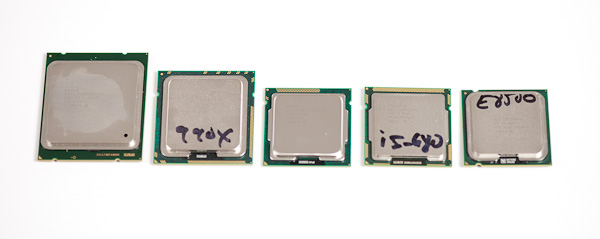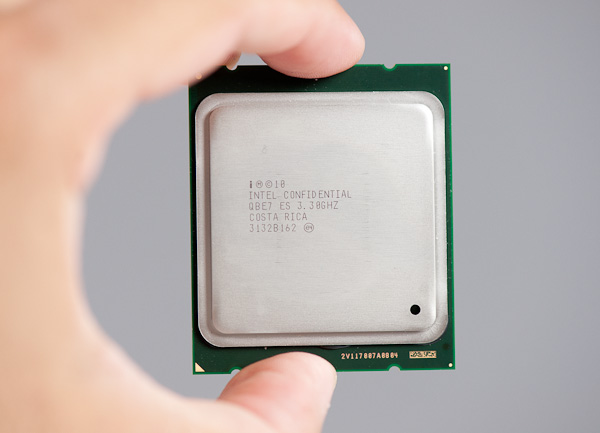Intel Core i7 3960X (Sandy Bridge E) Review: Keeping the High End Alive
by Anand Lal Shimpi on November 14, 2011 3:01 AM EST- Posted in
- CPUs
- Intel
- Core i7
- Sandy Bridge
- Sandy Bridge E
Final Words
There are two aspects of today's launch that bother me: the lack of Quick Sync and the chipset. The former is easy to understand. Sandy Bridge E is supposed to be a no-compromise, ultra high-end desktop solution. The lack of an on-die GPU with Quick Sync support means you have to inherently compromise in adopting the platform. I'm not sure what sort of a solution Intel could've come to (I wouldn't want to give up a pair of cores for a GPU+QuickSync) but I don't like performance/functionality tradeoffs with this class of product. Secondly, while I'm not a SAS user, I would've at least appreciated some more 6Gbps SATA ports on the chipset. Native USB 3.0 support would've been nice as well. Instead what we got was effectively a 6-series chipset with a new name. As Intel's flagship chipset, the X79 falls short.

From left to right: Intel Core i7 (SNB-E), Core i7 (Gulftown), Core i5 (SNB), Core i5 (Clarkdale), Core 2 Duo
LGA-2011, 1366, 1155, 1156, 775
The vast majority of desktop users, even enthusiast-class users, will likely have no need for Sandy Bridge E. The Core i7 3960X may be the world's fastest desktop CPU, but it really requires a heavily threaded workload to prove it. What the 3960X doesn't do is make your gaming experience any better or speed up the majority of desktop applications. The 3960X won't be any slower than the fastest Sandy Bridge CPUs, but it won't be tremendously faster either. The desktop market is clearly well served by Intel's LGA-1155 platform (and its lineage); LGA-2011 is simply a platform for users who need a true powerhouse.
There are no surprises there, we came to the same conclusion when we reviewed Intel's first 6-core CPU last year. If you do happen to have a heavily threaded workload that needs the absolute best performance, the Core i7 3960X can deliver. In our most thread heavy tests the 3960X had no problems outpacing the Core i7 2600K by over 50%. If your livelihood depends on it, the 3960X is worth its entry fee. I suspect for those same workloads, the 3930K will be a good balance of price/performance despite having a smaller L3 cache. I'm not terribly interested in next year's Core i7 3820. Its point is obviously for those users who need the memory bandwidth or PCIe lanes of SNB-E, but don't need more than four cores. I would've liked to have seen a value 6-core offering instead, but I guess with a 435mm2 die size it's a tough sell for Intel management.
Of course compute isn't the only advantage of the Sandy Bridge E platform. With eight DIMM slots on most high end LGA-2011 motherboards you'll be able to throw tons of memory at your system if you need it without having to shop for workstation motherboards with fewer frills.
As for the future of the platform, Intel has already begun talking about Ivy Bridge E. If it follows the pattern set for Ivy Bridge on LGA-1155, IVB-E should be a drop in replacement for LGA-2011 motherboards. The biggest issue there is timing. Ivy will arrive for the mainstream LGA-1155 platforms around the middle of 2012. At earliest, I don't know that we'd see it for LGA-2011 until the end of next year, or perhaps even early 2013 given the late launch of SNB-E. This seems to be the long-term downside to these ultra high-end desktop platforms these days: you end up on a delayed release cadence for each tick/tock on the roadmap. If you've always got to have the latest and greatest, this may prove to be frustrating. Based on what we know of Ivy Bridge however, I suspect that if you're using all six of these cores in SNB-E that you'll wish you had IVB-E sooner, but won't be tempted away from the platform by a quad-core Ivy Bridge on LGA-1155.
I do worry about the long term viability of the ultra high-end desktop platform. As we showed here, some of the gains in threaded apps exceed 50% over a standard Sandy Bridge. That's tangible performance to those who can use it. With the growth in cloud computing it's clear there's demand for these types of chips in servers. I just hope Intel continues to offer a version for desktop users as well.











163 Comments
View All Comments
mcturkey - Monday, November 14, 2011 - link
Glad I'm not the only one who was thinking that! My 486 66 only had 4MB as well.Anand Lal Shimpi - Monday, November 14, 2011 - link
My 386 started with 4MB, but I kept it for a very long time as upgrading was fairly expensive. I eventually threw a ton of memory at it as my last upgrade to the platform :)Take care,
Anand
BSMonitor - Monday, November 14, 2011 - link
How big was your 386's hard drive?How many times over could you store it's entire contents in 8 DIMM's of DDR3 memory, now ?? And for probably less cost!
Thought I saw a 16GB kit on newegg for $75? Lol!
just4U - Monday, November 14, 2011 - link
I had a roomie 81 meg harddrive in my 386/16khanov - Monday, November 14, 2011 - link
"With the socket the same, is the reviewed SB-E the same design as the new Xeons? Will there be 3D design like Ivy Bridge?"1. It is the exact same die as the new Xeons, although of course different parts are harvested for each market.
2. Yes there will be a 3D transistor design (according to rumors) but this will be Ivy Bridge-E and will not launch until at least late 2012.
gamoniac - Monday, November 14, 2011 - link
Anand,More and more power users are running VMs on their desktops or workstation. With most Intel and AMD CPU now support Intel-VT or AMD-V, I notice a lack of measurement in this department in pretty much all online reviews. When you update your test suite, could you possibly include some sort VM test? Note: If so, could you possibly run the VM test on SSD to eliminate HDD limitation?
Thanks for the great review and conclusion, as always.
Senti - Monday, November 14, 2011 - link
I'm amazed how much fuss QuickSync is still generating in reviews. Let's face it - it's fairly useless in current state. Cool words "GPU video transcoding" can only impress casual users, not someone who cares about quality in first place and speed only after that.With time it will be even more useless if like GPU video decoding it's unable to work with 10 bit and 422/444 content (very likely).
gunslinger5577 - Monday, November 14, 2011 - link
This review indicates no significant improvement with 2x 16x PCI-E lanes in SLI. However the ASUS X79 Pro MB review seems to indicate there is a measurable and significant at times advantage.fishbits - Monday, November 14, 2011 - link
Weird stuff. Why fret over on-die USB 3.0 when every mobo supports it? And mourning Quick Sync for a CPU that flies at encoding without it? Or when you'd already have an SNB with Quick Sync? Really unhappy with the new Porche's glove compartment...Love the CPU/Platform, but too pricey for how much I'd use it over what's currently available. Hoping against hope that mainstream Ivy offers 8 RAM slots, but not holding my breath.
DanNeely - Monday, November 14, 2011 - link
Each addon chip the mobo makers include increases the cost of the board (not just the chip itself, but the engineering time needed to integrate it, and potentially (if enough are chips are added) by adding an extra layer to the PCB).You also take a hit in the number of PCIe lanes available for expansion slots. With legacy PCI gone from the southbridge we're unlikely to see any 4x electrical slots coming off of it. Audio, ethernet, and firewire, will take 1 lane each; USB3 controllers will take 1lane/2 ports, probably 3lanes total/board leaving only 2 for expansion slots. THe main impact here is just not being able to go all USB3 for the legacy free gloss without a major squeeze elsewhere. Scientific customers doing stuff that actually needs the PCE 3.0 bandwidth without needing 2x width cards could end up being dinged since it means several fewer total lanes for them to hook stuff up to.